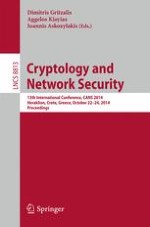2014 | Buch
Cryptology and Network Security
13th International Conference, CANS 2014, Heraklion, Crete, Greece, October 22-24, 2014. Proceedings
herausgegeben von: Dimitris Gritzalis, Aggelos Kiayias, Ioannis Askoxylakis
Verlag: Springer International Publishing
Buchreihe : Lecture Notes in Computer Science
